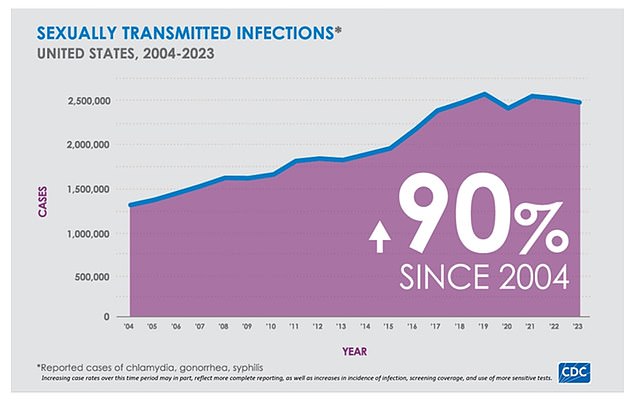Five Americans caught a sexually transmitted infection every minute last year as cases remained at a near record high.
But the CDC says there are signs the STI epidemic is slowing after spiking 90 percent in the last 20 years.
Official data released today showed there were 2.4million sexually transmitted infections in 2023, which was up just 3 percent compared to the previous year.
In recent years, annual infections have increased by more than 30 percent. The CDC said the figures provided a ‘glimmer of hope.’
Jonathan Mermin, Director of CDC’s National Center for HIV, Viral Hepatitis, STD, and TB Prevention, added: ‘After nearly two decades of STI increases, the tide is turning.
‘We must make the most of this moment—let’s further this momentum with creative innovation and further investment in STI prevention.’
A major resurgence of syphilis over the past 20 years, including among newborn babies, has kept doctors awake at night. But after years of double-digit increases, cases rose by just one percent.
Meanwhile gonorrhea cases fell for a second year, declining 7 percent from 2022 and falling below pre-pandemic levels. Chlamydia case rates remained stable.

The CDC says there are signs the STI epidemic is slowing after spiking 90 percent in the last 20 years
In 2023, the reported chlamydia rate was about 493 per 100,000 people, close to the 2021 rate of 495 per 100,000.
Between 2022 and 2023, the rate increased by 1.3 percent in men but dropped by 1.7 percent in women.
The updated figures provide some much-needed good news on the sexual health front as more and more young people report rarely or never using condoms while fewer and fewer schools provide comprehensive and potentially lifesaving sex education.
Chlamydia was the most commonly reported STI in 2023 with 1.6 million cases, followed by gonorrhea with 600,000 cases.
While syphilis was less common, it remains a major public health concern.
Rates of the disease plummeted in the 1940s with the advent of modern antibiotics and widespread use of condoms.
By the late 90s, the CDC was convinced the disease could be eradicated, and set up the National Plan to Eliminate Syphilis from the United States. By 2002, cases started to rise again, disproportionately affecting men who have sex with men.

There were 2.4million sexually transmitted infections in 2023, which was up just 3 percent compared to the previous year
But the good news in the latest CDC data is that Primary and secondary syphilis cases, the most contagious stages of the disease, dropped by 10 percent —the first significant decrease in over 20 years.
Among gay and bisexual men, cases fell by 13 percent, marking the first decline since the CDC started tracking national trends for this group in the mid-2000s.
The rise in congenital syphilis cases in newborns – passed to them in utero by their mother – seems to be slowing in some regions, with a 3 percent increase nationally in 2022, compared to the 30 percent annual increases seen in previous years.
Congenital syphilis raises an infant’s risk of bone damage, anemia, jaundice, nerve damage and meningitis.
The disease kills about 40 percent of babies born with it, but treatment is possible with medication.

Symptoms of syphilis include sores which can erupt across the body in more serious cases of infection. The patient shown above had syphilis and an HIV infection
A new ‘morning after’ pill could be the secret to improving STD trends. But this pill is not aimed at preventing pregnancy.
Instead, it’s the antibiotic doxycycline.
The CDC endorsed three large studies showing that men who have sex with men and transgender women who take 200 mg of doxycycline within 72 hours after sex can reduce syphilis and chlamydia by over 70 percent and gonorrhea by about 50 percent.
STIs that go untreated can wreak lasting damage on the body including neurological decay and infertility in both men and women.
This article was originally published by a www.dailymail.co.uk . Read the Original article here. .


